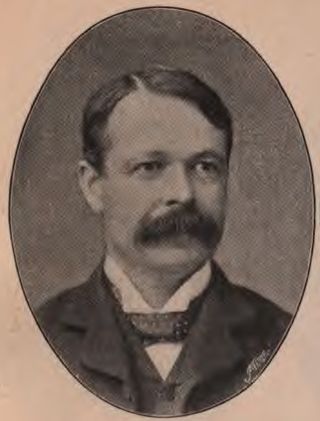
William Kent was an English architect, landscape architect, painter and furniture designer of the early 18th century. He began his career as a painter, and became Principal Painter in Ordinary or court painter, but his real talent was for design in various media.

Rufus Choate was an American lawyer, orator, and Senator who represented Massachusetts as a member of the Whig Party. He is regarded as one of the greatest American lawyers of the 19th century, arguing over a thousand cases in a lifetime practice extending to virtually every branch of the law then recognized. Notably, he was one of the pioneers of the legal technique of arousing jury sympathy in tort cases. In one instance, he successfully won a record judgement of $22,500 for a badly injured widow, the most ever awarded to a plaintiff at the time.

Colman's is an English manufacturer of mustard and other sauces, formerly based and produced for 160 years at Carrow, in Norwich, Norfolk. Owned by Unilever since 1995, Colman's is one of the oldest existing food brands, famous for a limited range of products, almost all being varieties of mustard.

Carrow Road is a football stadium in Norwich, Norfolk, England, and is the home of EFL Championship club Norwich City. The stadium is east of the city, near Norwich railway station and the River Wensum.

James Stuart PC was a British educator and politician. He was born in Markinch, Fife, and attended Madras College and the University of St Andrews before going to Trinity College, Cambridge. He later became a Fellow of the College and Professor of Mechanism and Applied Mechanics at Cambridge University from 1875; he was also Lord Rector of St Andrews from 1898 to 1901. Stuart was interested in popularising scientific topics and published several books on the subject.

The Jarrold Group is a Norwich–based company, founded as Jarrold & Sons Ltd, in 1770, by John Jarrold, at Woodbridge, Suffolk, before relocating to Norfolk in 1823. The Jarrold Group still involves members of the Jarrold family.
The Hart wrestling family, sometimes known as the Hart dynasty, is a mainly Canadian family with a significant history within professional wrestling. The patriarch of the family was wrestling legend Stu Hart (1915–2003). An amateur and professional wrestling performer, promoter and trainer, Stu owned and operated his own wrestling promotion, Stampede Wrestling. He also trained some of the most well known stars in wrestling history including "Superstar" Billy Graham, Fritz Von Erich, Chris Jericho, Chris Benoit, and his own sons Bret Hart and Owen Hart.

The Martineau family is an intellectual, business and political dynasty associated first with Norwich and later also London and Birmingham, England. Many members of the family have been knighted. Many family members were prominent Unitarians; a room in London's Essex Hall, the headquarters building of the British Unitarians, was named after them. Martineau Place in Birmingham's central business district was named in their honour.
Jeremiah James Colman was an English mustard manufacturer and the third member of the family in charge of the eponymous company Colman's. He was a popular philanthropist in his home town of Norwich and a Liberal politician who represented the city in parliament.

Carrow Abbey is a former Benedictine priory in Bracondale, southeast Norwich, England. The village on the site used to be called Carrow and gives its name to Carrow Road, the football ground of Norwich F.C., located just metres to the north. Granted by charter of King Stephen, the abbey was founded ca. 1146, and became a Grade I listed building in 1954.

Hathor (1905) is one of only six surviving Norfolk pleasure wherries to be found on the Norfolk Broads. Like two of the other surviving wherries, Maud and Solace, she was built by Daniel S. Hall of Reedham. Hathor has been listed on the register of National Historic Ships in the United Kingdom since 1996 and is part of the National Historic Fleet.

My Life with Caroline is a 1941 American comedy film directed by Lewis Milestone and starring Ronald Colman and Anna Lee, in her second Hollywood film and her first in a starring role. The supporting cast featured Charles Winninger, Reginald Gardiner and Gilbert Roland. The screenplay was written by John Van Druten and Arnold Belgard.

Edward Boardman (1833–1910) was a Norwich born architect. He succeeded John Brown as the most successful Norwich architect in the second half of the 19th century. His work included both civic and ecclesiastical buildings, in addition to private commissions. Together, with his rival, George Skipper, he produced many notable buildings with several standing to this day (2013).
The following is a timeline of the history of the city of Norwich, Norfolk, England.
Reckitt and Sons was a leading British manufacturer of household products, notably starch, black lead, laundry blue, and household polish, and based in Kingston upon Hull.

John Thirtle was an English watercolour artist and frame-maker. Born in Norwich, where he lived for most of his life, he was a leading member of the Norwich School of painters.
Louisa Elizabeth How (1821–1893) was the first woman photographer in Australia whose works survive.

Ethel Mary Colman was a philanthropist and a member of the Colman family who was Lord Mayor of Norwich in 1923–24. Colman is notable for having been the first woman to be a Lord Mayor in the United Kingdom.
Simon Willard (1605–1676) family:

Carrow Works is a former factory site in Norwich previously owned by condiment manufacturer Colman's. The site covers 40 acres, and several of the buildings within its bounds are Grade II listed, as well as the Grade I listed Carrow Abbey. In production for 165 years, the site has been referred to as "historic" due to its impact on the industry and character of Norwich.













